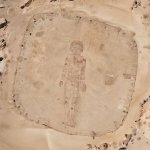Nothing To See Here.
The Blythe Intaglios: Ancient geoglyphs covering 10 square miles in California's desert, showcasing human figures, animals, and patterns carved into the earth by indigenous peoples between 200 BC and 900 AD. Their true purpose remains a mystery
The Blythe Intaglios, a fascinating collection of over 200 geoglyphs etched into the California desert, span 10 square miles (26 square kilometers) and represent one of North America’s great archaeological enigmas. These massive designs, featuring human figures, animals, and geometric shapes, were created by indigenous peoples between 200 BC and 900 AD. Crafted by scraping away the dark desert surface to reveal lighter soil below, the intaglios were likely intended to be seen from above—perhaps by deities or spiritual beings, as some researchers speculate.
The most striking among them is a human figure stretching over 170 feet (52 meters) long, hinting at the immense scale of the creators’ vision. The exact purpose of the Blythe Intaglios, however, remains uncertain. No written records or oral traditions have survived to explain their meaning, leaving their significance shrouded in mystery.
Some theories suggest the geoglyphs may have held ceremonial or religious importance, possibly used in ancient rituals or as markers for sacred sites. Others believe they might align with celestial patterns, revealing an early understanding of astronomy. For now, the Blythe Intaglios stand as a breathtaking testament to the ingenuity and artistry of the ancient peoples of the Colorado Desert, inviting ongoing exploration into the past.





